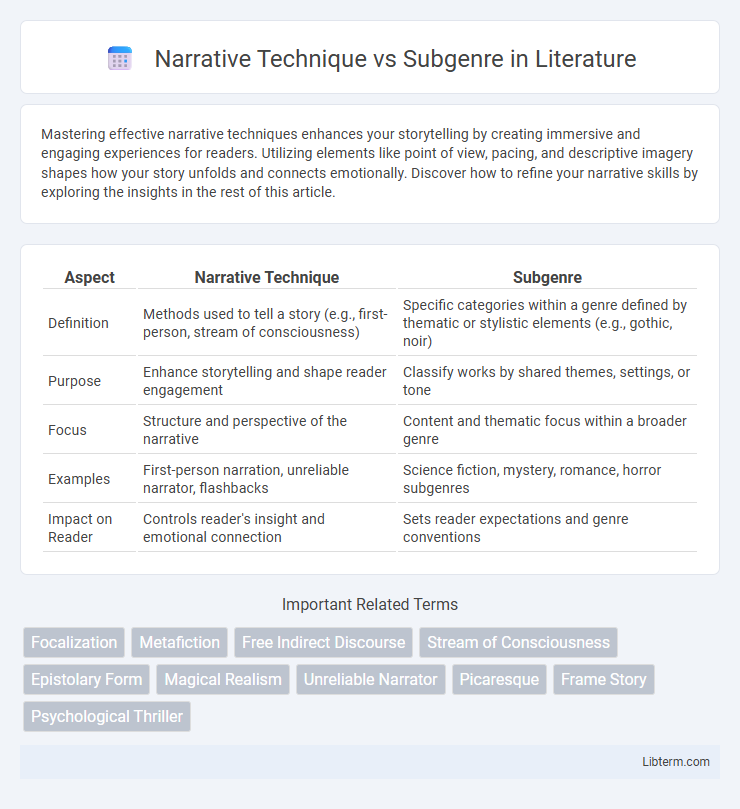Mastering effective narrative techniques enhances your storytelling by creating immersive and engaging experiences for readers. Utilizing elements like point of view, pacing, and descriptive imagery shapes how your story unfolds and connects emotionally. Discover how to refine your narrative skills by exploring the insights in the rest of this article.
Table of Comparison
| Aspect | Narrative Technique | Subgenre |
|---|---|---|
| Definition | Methods used to tell a story (e.g., first-person, stream of consciousness) | Specific categories within a genre defined by thematic or stylistic elements (e.g., gothic, noir) |
| Purpose | Enhance storytelling and shape reader engagement | Classify works by shared themes, settings, or tone |
| Focus | Structure and perspective of the narrative | Content and thematic focus within a broader genre |
| Examples | First-person narration, unreliable narrator, flashbacks | Science fiction, mystery, romance, horror subgenres |
| Impact on Reader | Controls reader's insight and emotional connection | Sets reader expectations and genre conventions |
Introduction to Narrative Techniques and Subgenres
Narrative techniques refer to the specific methods and styles writers use to tell a story, such as first-person narration, stream of consciousness, or unreliable narrators, which shape the reader's experience and understanding. Subgenres, like detective fiction, fantasy, or historical romance, categorize stories based on recurring themes, settings, and plot structures, influencing the narrative methods employed. Understanding the interplay between narrative techniques and subgenres enhances literary analysis by revealing how storytelling approaches align with or challenge genre conventions.
Defining Narrative Technique
Narrative technique refers to the specific methods and structures an author uses to tell a story, including point of view, time manipulation, and voice. It focuses on how the story is conveyed to the reader rather than the story's content or theme, which is the domain of subgenre classification. Understanding narrative technique enables deeper analysis of literary works beyond the conventional boundaries of subgenres such as mystery, romance, or science fiction.
Understanding Literary Subgenres
Understanding literary subgenres requires analyzing how specific narrative techniques shape the story's form and reader experience. Narrative techniques such as unreliable narration, stream of consciousness, or multiple perspectives define subgenres by influencing plot structure and thematic emphasis. Recognizing these techniques enables precise classification and deeper appreciation of the diverse styles within literary categories like mystery, science fiction, or historical fiction.
Key Differences Between Narrative Technique and Subgenre
Narrative technique refers to the specific methods and styles used by an author to tell a story, such as first-person narration, flashbacks, or stream of consciousness, while subgenre categorizes a work within a broader genre based on thematic and stylistic elements, like noir detective fiction or epic fantasy. The key difference lies in narrative technique shaping the story's delivery and reader experience, whereas subgenre defines the story's content and genre conventions. Understanding narrative techniques enhances literary analysis by focusing on storytelling methods, whereas identifying subgenres aids in audience targeting and market classification.
How Narrative Techniques Shape Storytelling
Narrative techniques such as first-person narration, unreliable narrators, and nonlinear timelines profoundly shape storytelling by influencing readers' perception and engagement within specific subgenres like mystery, science fiction, and historical fiction. The use of stream of consciousness in psychological thrillers deepens character insight, while flashbacks and multiple perspectives enhance complexity in literary fiction and fantasy subgenres. Employing distinct narrative approaches allows authors to manipulate pacing, build suspense, and develop immersive worlds that align with and enrich subgenre expectations.
The Role of Subgenre in Literature
Subgenres in literature function as distinct categories that shape the narrative techniques employed by authors to meet specific thematic and stylistic expectations. By aligning narrative methods such as point of view, pacing, and tone with subgenre conventions--like the suspense-building techniques in psychological thrillers or the world-building elements in epic fantasy--writers engage targeted audiences more effectively. Understanding the role of subgenre enhances the analysis of how narrative structures are tailored to fulfill genre-specific storytelling goals.
Common Narrative Techniques Across Subgenres
Common narrative techniques across subgenres include first-person and third-person perspectives, nonlinear storytelling, and unreliable narrators, which shape the reader's engagement and interpretation. Techniques such as flashbacks, multiple viewpoints, and stream of consciousness enhance thematic depth and character development within mystery, romance, fantasy, and science fiction subgenres. Mastery of these techniques allows authors to tailor narrative style to subgenre conventions, creating immersive and compelling storytelling experiences.
Case Studies: Narrative Technique vs Subgenre in Popular Works
Analyzing case studies in popular works reveals how narrative techniques shape subgenre classification and reader engagement. For example, unreliable narration in psychological thrillers deepens suspense, while nonlinear storytelling is a hallmark of experimental fiction. These techniques directly influence thematic development and audience interpretation within specific subgenres.
Choosing the Right Technique for Your Subgenre
Selecting the appropriate narrative technique is crucial for enhancing the impact of your subgenre, as different subgenres demand specific storytelling methods to engage their audience effectively. For example, a first-person perspective intensifies emotional connection in psychological thrillers, while an omniscient narrator suits epic fantasy to convey vast world-building. Understanding your subgenre's conventions and reader expectations guides the choice of narrative style, ensuring the story's tone and structure align perfectly.
Conclusion: Integrating Narrative Technique with Subgenre
Integrating narrative technique with subgenre enhances storytelling by aligning distinct methods such as first-person perspective or unreliable narration with the specific conventions of genres like mystery or fantasy. This fusion deepens thematic exploration and emotional impact, creating a more immersive reader experience. Effective integration demands careful consideration of how narrative choices complement subgenre expectations to enrich plot development and character complexity.
Narrative Technique Infographic

 libterm.com
libterm.com